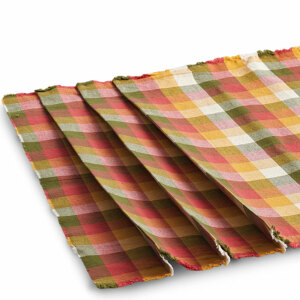
Q: Why do some patterns say “Unsuitable for obvious diagonals”? Other patterns have a warning that “Extra fabric is needed to match plaids, stripes, or one-way design fabrics.” I’m almost afraid to use any fabric that isn’t solid.
—Pam Derrick, via email
A: Dana Finkle, guidesheet composer at McCall’s, Butterick, Simplicity, and Vogue Patterns, and a former Threads assistant editor, offers background and advice on diagonal fabric patterns:
First, these notes should be viewed as cautions rather than prohibitions.
According to my research, Simplicity patterns used to include fabric-cutting diagrams on the instruction sheets that showed how to orient the pattern pieces on fabric when working with plaids, stripes, and one-way design fabrics. At one point, however, the company stopped including these specialty fabric-cutting diagrams. It also stopped calculating and listing how much fabric would be needed for these layouts. This information was replaced with the generic “Extra fabric needed . . .” note on the back of each envelope.
Similarly, the warning against diagonals tends to remain printed on the back of each garment pattern envelope, regardless of the design. (Craft patterns, on the other hand, don’t typically include either note, since matching prints isn’t usually necessary.)
With Butterick, McCall’s, and Vogue Patterns, this note is intended to clarify that the pattern’s instructions don’t include diagrams explaining how to cut fabrics with diagonal prints. For this reason, the brands suggest avoiding these fabrics altogether, since they can present challenges when matching lines and motifs.

If you are an experienced sewer and would like to sew a garment with a diagonal print, I wouldn’t let this note deter you. Just know that you shouldn’t necessarily follow the cutting diagrams, and you will need to buy more fabric than the pattern suggests. In addition, the more pattern pieces and seams a garment has, the harder it is to match diagonal prints.
Therefore, it might be best to start with a basic pattern. As when matching any motif, a single-layer layout generally gives you control for a more accurate result.
It is interesting to note that these three pattern brands suggest staying away from diagonal prints, several of their patterns do make use of striped fabric cut on the bias, which results in a diagonal stripe. So, even though it looks as if these patterns call for diagonal prints, they are using horizontally or vertically striped fabrics to get the desired effect.
Photos: Mike Yamin Illustration: Dana Finkle
Have a Question? Send it to us and we’ll find an expert’s answer.
via mail: Threads Q&A, PO Box 5506, Newtown, CT 06470-5506
via email: ThreadsQ&[email protected]
via the Contact the staff page to submit your entry


































Log in or create an account to post a comment.
Sign up Log in